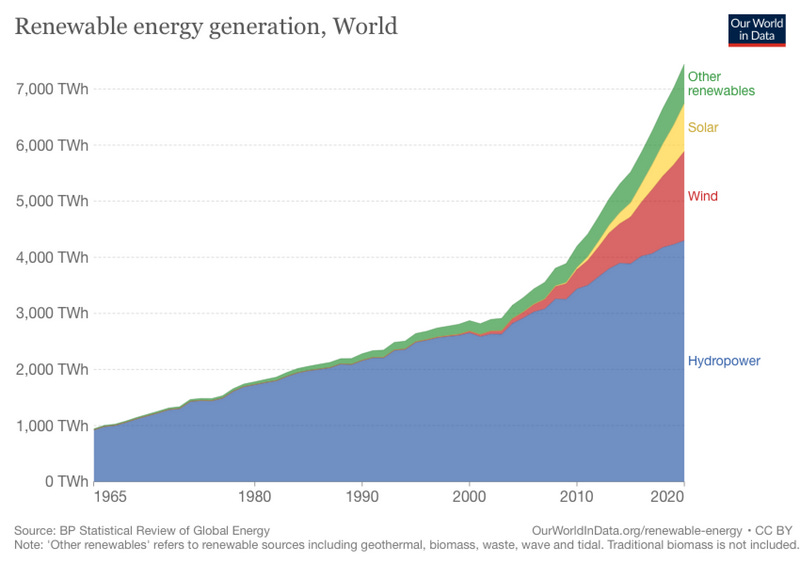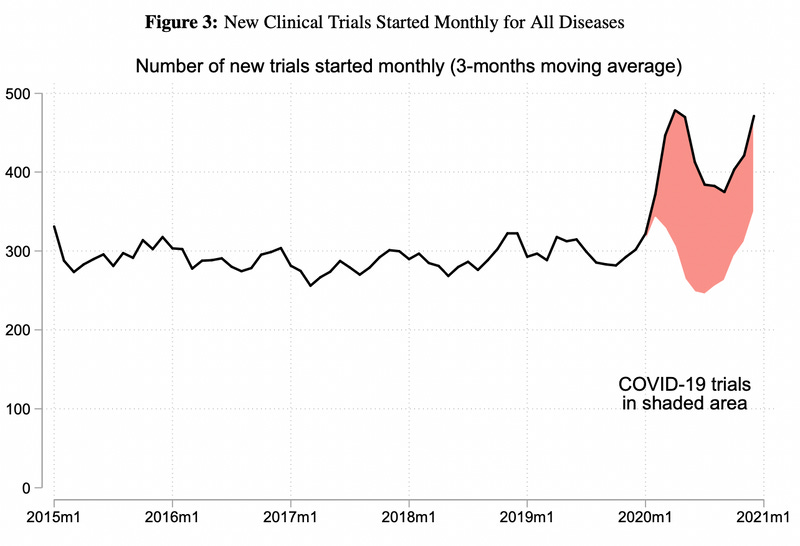Like the rest of New Things Under the Sun, this article will be updated as the state of the academic literature evolves; you can read the latest version here.
Audio versions of this and other posts: Substack, Apple, Spotify, Google, Amazon, Stitcher.
We all know the proverb “Necessity is the mother of invention.” This proverb is overly simplistic, but it gets at something true. One place you can see this really clearly is in global crises, which vividly illustrate the linkage between need and innovation, without the need for any fancy statistical techniques.
Let’s look at three examples.
Crisis #1: Covid-19 Global Pandemic
Our first crisis is the one we’re all most familiar with: the covid-19 global pandemic. During 2020-2022, the big thing we suddenly needed was medical treatment for covid-19. Agarwal and Gaule (2022) look at what happened to the number of new clinical trials (for all diseases) in the wake of the pandemic.1 No surprises: the number of new clinical trials shot up as the magnitude of the disease became clear, with essentially all of the increase coming from trials related to covid-19.
In the end, these trials succeeded and we got a suite of effective vaccines in record time: necessity was the mother of invention.
Covid-19 had other effects too. For one, it forced the world to embark on an unprecedented experiment in remote work. Bloom et al. (2021) is a short paper that looks at the share of patent applications, filed in the USA, that relate to remote work. Bloom and coauthors scan the text of patent applications for words related to remote work, such as “work remotely”, “telework”, “video chat”, and many others. As we can see in the figure below, covid-19 induced a step change in the share of patents related to working remotely. Again, necessity was the mother of invention.

Crisis #2: Oil Shocks
Our second crisis is the oil price shocks of the 1970s. After a long period of relatively stable and predictable energy prices, the price of oil abruptly shot up due to disruptions to Middle Eastern supply in the 1970s. The energy crisis created an urgent need to pivot away from dependence on suddenly unreliable oil supplies. Suggestive evidence that the US economy managed to do just that comes from the following figure from Hassler, Krusell, and Olovsson (2021). The black line is the share of GDP spent on energy, the dashed line tracks the price of energy in the USA.
Around 1985 the link between the share of GDP spent on energy and the price of energy seems to have changed (in the figure, the black line moved from above the dashed one to below). That suggests the economy got better at getting more GDP out of less energy.
But it’s still not 100% clear how the timing of this all played out; was this really that closely related to the oil shocks? To more precisely estimate the pace of innovation related to energy, Hassler, Krusell, and Olovsson (2021) use some fairly basic economic modeling. They assume economic output is produced by labor and energy, and that technology comes in two flavors, one for each. If the technology for energy gets twice as good, it’s as if you’ve got twice as much energy to play with (when in fact, better technology allows you to use the energy you’ve got twice as efficiently). Similarly, if labor technology gets twice as good, it’s as if you’ve got twice as much labor to work with.
The cool thing is that if you accept their pretty simple model, you end up with a way to measure a concept like “technology”, which is normally so nebulous, with some very simple and readily available data. If you assume the economy uses labor and energy efficiently, you can do some math, move things around, and show that the productivity of the energy technology can be expressed as a function of GDP per capita, the share of spending on energy in the economy, and our ability to substitute labor for energy and vice-versa. That’s almost all stuff we can measure. When Hassler, Kruseell and Olovsson plug data into this equation and make some sensible assumptions about our ability to substitute labor for energy (they assume its quite hard), you get the following striking chart tracking our ability to convert energy into economic output. Here, the blue line is a measure of how technology multiplies the energy supply, so that having one barrel of oil in 2020 is like having 3 in 1950.
Now it’s crystal clear: the oil shocks knocked productivity of energy technology out of its stagnation and into a steady upward trend. Necessity was the mother of invention.
An aside: sometimes, people argue one reason technological progress slowed in the 1970s, because we moved from technological progress that took abundant energy for granted to technological progress that did not. Hassler, Krusell, and Olovsson’s work is broadly supportive of that narrative. This is just three data points, so don’t get too excited, but there does seem to be a negative correlation between the pace of progress in technology that converts energy into output and technology that converts labor into output. In other words, when the oil shocks forced us to expend more effort on reducing demand on fossil fuels, that may have come at the expense of other forms of technological progress that we had become accustomed to.
Crisis #3: World War II
Our last crisis is World War II. We could point to many innovations born out of the exigencies of World War II: radar to defend against attack from the air; penicillin produced at industrial scale; and the Manhattan project to develop the first atomic bomb.
But let’s focus on the need to build a lot of airplanes. When President Roosevelt targeted 50,000 planes over the war in 1940, this goal was viewed as simply impossible by many: contemporary economists Robert Nathan and Simon Kuznetz believed the US simply didn’t have the productive capacity to do it (Ilzetzki 2022). And yet, in reality, the US eventually succeeded in producing 100,000 planes in just one year. During the war, there was a 1,600% increase in the number of aircraft produced, and US spending on aircraft alone reached 10% of 1939 GDP.
How did the US manage to do the seemingly impossible? The following figure from Ilzetzki (2022) gives some clues. It shows total US aircraft produced (measured by weight), as well as the capital and labor used to produce aircraft, relative to 1942 levels.

Initially, the US made more airplanes by using more labor and more capital to make airplanes. But after 1943, something surprising happened: the increase in capital and labor slowed or even stopped, but we kept on increasing how many planes we made! In order to meet their ambitious targets, airplane manufacturers were forced to discover new efficiencies. And they did! Necessity was the mother of invention.
Ilzetski actually goes much further, and tracks the productivity of individual airplane manufacturers. He shows that, on average, individual manufacturers became more productive when they received more plane orders, and that this effect was greatest for the manufacturers who were already operating closest to capacity. In other words, the manufacturers who had the least ability to meet their aircraft orders by increasing labor or capital were also the ones who most improved their productivity!
Invention Has Two Parents
The above examples illustrate how sudden new necessities can indeed drive innovative effort. And I’ve written elsewhere about evidence that demand for new technologies, even in non-crisis settings, can also spur innovative effort. For example, the private sector tends to do more R&D on treatments for diseases that become more profitable to treat, and automobile manufacturers developed more fuel efficient vehicles in response to fuel efficiency standards and high energy prices.
But we need to be careful not to take this too far. You cannot will technologies into being, simply because someone needs them (if so, we wouldn’t have waited so long for mRNA vaccines and atomic bombs).
Invention has two parents. A truer proverb might be “Necessity and knowledge are the parents of invention.”
We can also see this in some of the examples just cited.
As discussed in a bit more detail here, most of the new clinical trials for covid-19 were not for fundamentally new kinds of drugs. Instead, they were largely attempts to re-deploy existing drugs to a novel use case. In other words, they were attempts to take what was already known to be safe and see if it had beneficial effects on covid-19. Most of these failed.
The covid-19 vaccines that eventually succeeded rested on deep foundations of fundamental research that went back decades. Covid-19 was the impetus to transform this knowledge into effective new treatments (though these efforts were already underway before covid-19), but it didn’t give us the knowledge that made that possible.
Most of the radical technologies developed during World War II, such as radar and the atomic bomb, relied on breakthroughs in fundamental science that preceded the war. In a 2020 review of the activities of the US Office of Scientific Research and Development, which oversaw these and many other technological breakthroughs of the war, Gross and Sampat write “the time for basic research is before a crisis, and since time was of the essence, ‘the basic knowledge at hand had to be turned to good account.’”
Ilzetski shows much of the improvement in airplane manufacturing came from adopting techniques that had been shown to be effective in other sectors, rather than inventing new processes out of whole cloth. Specifically, airplane manufacturers that faced capacity constraints were more likely to adopt production line processes (instead of making planes in a custom, artisanal process), outsourcing, and new labor management techniques to reduce attrition and quits.
With respect to the energy crisis, although the crisis initiated a new research program devoted to greater energy efficiency and alternative energy sources, the gains came slowly and steadily, with much of the payoff arriving well after energy prices had already subsided. Renewable energy did not displace a significant share of fossil fuels for decades:

Crises show us that we are capable of rapidly responding to new exigencies with new solutions. But precisely because crises call for solutions urgently, those living in them do not have the luxury of waiting for fundamental science to advance and then make possible perfect solutions. Because crises force us to use the knowledge at hand, it is important to enter crises with a deep well of knowledge.
New Things Under the Sun is produced in partnership with the Institute for Progress, a Washington, DC-based think tank. You can learn more about their work by visiting their website.
Agarwal and Gaule also look at a lot more of interest in the paper, but this post is about how crises create opportunities for compelling but dead-simple charts so I had to leave the rest to the side for now. Similarly, most of the other papers covered in this post do much more than generate the charts I chose to highlight.







A lot of interesting data and analysis came out of World War II.
Some of the actions taken to secure manpower are only likely to be acceptable in time of war; see: THE ARMY AND INDUSTRIAL MANPOWER
https://history.army.mil/html/books/001/1-8/CMH_Pub_1-8.pdf
There is lots of interesting production data in: Munitions Production OF THE UNITED STATES BY MONTHS, JULY I, 1940 - AUGUST 31, 1945, available at: https://cgsc.contentdm.oclc.org/digital/collection/p4013coll8/id/3332
Insightful and important post. The implication for the climate transition is clear: we need to get better at the end to end flow of knowledge, from invention to scaled up innovation - by making sure that we leverage more intentionally the research that’s already happened. I recently argued that the infrastructure to do that is underdeveloped https://www.linkedin.com/pulse/cut-climate-tech-invention-to-innovation-time-gianni-giacomelli